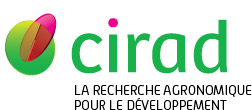Xuan Lam Mai Thi, Thi Xuan Trinh, Huynh Ky, Rivière Jean-Noël, Rouget Mathieu, Ngoc Nguyen Truc Thi, Do Van Truong, Hoa Tran Dang, Quang Diep Dinh, Jagou Marie-Stella, Van Quoc Giang, Martos Florent, Borowiec Nicolas, Siegwart Myriam, Le Anh Tuan, Dang Khoa Tran, Phuong Dong Tran, Van Sy Hoang, Lefeuvre Pierre, Deguine Jean-Philippe.
2024. Status of the Helicopter flower Hiptage benghalensis (Malpighiaceae) in Vietnam : distribution, bioecology and natural enemies. Perspectives of biological control in invasive areas.
|
Version publiée
- Anglais
Accès réservé aux personnels Cirad Utilisation soumise à autorisation de l'auteur ou du Cirad. Abstract Mai et al 2024 ICAS2024.pdf Télécharger (16kB) | Demander une copie |
Résumé : Hiptage benghalensis (L.) Kurz (Malpighiaceae) is a perennial woody vine or shrub, native to India, Southern China, Southeast Asia, and the Philippines. Originally introduced worldwide as an ornamental plant due to its attractive and fragrant flowers, after adapting time, H. benghalensis has become invasive in some introduced areas, including Reunion (France), Mauritius, Florida and Hawaii (US), and Queensland (Australia). H. benghalensis is listed as one of the world's 100 worst invasive species; it causes severe ecological damage to native flora and fauna. In Reunion Island (France), the most heavily invaded area, around 969 ha including conservation areas are now invaded. The plant creates intertwining vines and creepers that cover tree canopies, forming dense thickets that block light and hinder the growth of native plants, establish monospecific colonies on this island. Chemical and mechanical control methods have proved unsuccessful or mostly impracticable due to the challenging terrain and extensive nature of the invasion. Biological control is seen as the most feasible option, based on the hypothesis that the plant's success in invaded areas is due to the absence of its natural enemies. Therefore, a project on the biological control of H. benghalensis has been initiated, mobilizing most of the activities in Vietnam where this plant occurs naturally.. After two years of studying, we have developed a distribution map for H. benghalensis, identifying twelve sites across three northern provinces and one central province of Vietnam. These sites encompass a variety of habitats, ranging from natural areas and protected forests to medicinal plant centers. The rich diversity of the Hiptage genus in Vietnam is also highlighted by the presence of five additional species: H. candicans, H. lucida, H. tianyangensis, H. marginata, and an a new Hiptage species with wingless fruits. After search of the biocenose of plants from all these Hiptage species, a total of 262 organisms affecting leaves, flowers, fruits, and stems was obtained. Among these, two species of Skipper butterfly (Hesperiidae) are the most promising: The larvae of these species are found in most places where Hiptage plants are present,feed on the entire leaf tissue and cause significant damages. The laravae can grow up to 5 cm in size and have a larval period lasting over 30 days. It was found in various temperature and ecological zones, adapt to hot climates, so it could potentially adapt to Reunion Island climates. Additional biocenosis collects are underway to characterise biocenosis across different seasons. Further studies will then be performed to assess the efficacy of these potential agents in controlling H. benghalensis, including tests to ensure biosafety for a potential introduced area.
Mots-clés libres : Hiptage benghalensis, Vietnam, Biological Control, Biocenosis, Réunion
Auteurs et affiliations
- Xuan Lam Mai Thi, Can Tho University (VNM)
- Thi Xuan Trinh, Can Tho University (VNM)
- Huynh Ky, Can Tho University (VNM)
- Rivière Jean-Noël, CIRAD-BIOS-UMR PVBMT (REU)
-
Rouget Mathieu, CIRAD-BIOS-UMR PVBMT (REU)
 ORCID: 0000-0002-6172-3152
ORCID: 0000-0002-6172-3152
- Ngoc Nguyen Truc Thi, SOFRI (VNM)
- Do Van Truong, Vietnam Academy of Science and Technology (VNM)
- Hoa Tran Dang, University of Agriculture and Forestry (VNM)
- Quang Diep Dinh, Thu Dau Mot University (VNM)
- Jagou Marie-Stella, CNRS (FRA)
- Van Quoc Giang, Can Tho University (VNM)
- Martos Florent, MNHN (FRA)
- Borowiec Nicolas, INRAE (FRA)
- Siegwart Myriam, INRAE (FRA)
- Le Anh Tuan, Vietnam Academy of Science and Technology (VNM)
- Dang Khoa Tran, University of Agriculture and Forestry (VNM)
- Phuong Dong Tran, University of Agriculture and Forestry (VNM)
- Van Sy Hoang, University of Agriculture and Forestry (VNM)
-
Lefeuvre Pierre, CIRAD-BIOS-UMR PVBMT (VNM)
 ORCID: 0000-0003-2645-8098
ORCID: 0000-0003-2645-8098
- Deguine Jean-Philippe, CIRAD-BIOS-UMR PHIM (FRA)
Source : Cirad-Agritrop (https://agritrop.cirad.fr/611686/)
[ Page générée et mise en cache le 2025-01-31 ]




